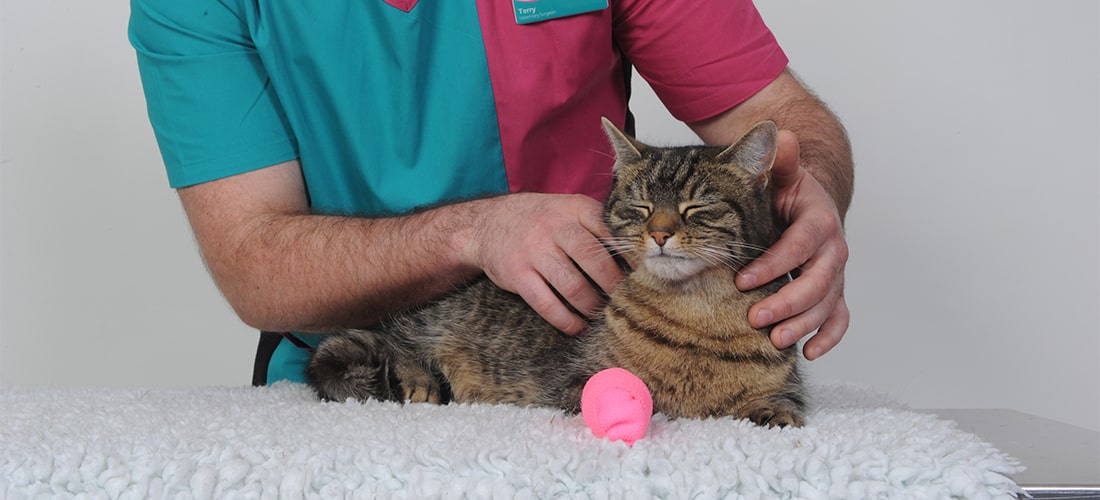How can I tell if my pet still has a good quality of life?
All pet owners want their companion to have a good life. As your pet gets older, or if they’re diagnosed with a serious illness, you may worry that they’re suffering and have more bad days than good.
It can be easy to tell if your pet has a really good quality of life – they’re still playful, active, comfortable and enjoying their food normally. Sometimes, it’ll be very noticeable that your pet is in pain and is suffering after an accident or a sudden illness. But it’s more difficult to notice problems when your pet’s quality of life gradually changes over time.
As owners, we get used to the ways our pets slow down as they age and the extra medications they might need to take. It can be difficult to tell when things start to deteriorate and, emotionally, we might not want to admit that they’re struggling.
It’s important for us to be aware of when things might be getting too much for our pet. It means we can start to prepare ourselves for saying goodbye and ensure that our beloved friend won’t suffer.
Measuring your pet's quality of life

Quality of life isn’t measured by just one ‘thing’ – it takes into account all of the parts of your pet’s mental and physical wellbeing. This means it can be difficult to measure.
Your vet can help you measure your pet’s quality of life. But your vet only sees your pet during an appointment, and they know you are best-placed to understand how they are getting on day to day.
If their quality of life is getting worse, this doesn’t always mean that it’s time to say goodbye. It’s always best to visit the vet if you notice a change in your pet, even if they already have a diagnosis of a serious illness. There may be other medications or management techniques to help your pet. If other options are not right for your pet, then your vet can give you guidance on when it might be time to say goodbye. The vet will only recommend this as a last resort, if they feel it would prevent your pet from further suffering.
You can use the pointers below to regularly check on your pet’s quality of life. It’s good to do this regularly as it can help you spot when things are starting to change
1. Are they in pain?
- Do they shake, tremble or pant even when they’re resting?
- Do they hide away and not want to be touched or stroked?
- Does it seem to you that their pain medication has stopped working?
2. Are they struggling to get around?
- Do they struggle to get up without your help?
- Are they unable to exercise, even just gently?
- Do they lie in the same place all day?
- Do they often fall over or lose their balance?
- Do they pant more than usual or seem to be struggling for breath?
- Are they having frequent seizures or episodes of collapsing?
3. Are they eating and drinking normally?
- Have they lost interest in food, even turning down their favourite treats?
- Are they drinking less than normal?
- Are they being sick or suffering from diarrhoea?
- Are they losing weight?
4. Are they going to the toilet normally?
- Has your cat stopped using the litter tray?
- Is your dog struggling to let you know when they need to go outside?
- Is your pet pooing and weeing where they rest?
5. Can they keep themselves clean?
- Do they smell of wee or can’t keep their bum clean?
- Does their fur look duller and less healthy than it used to?
- Is your pet’s fur becoming matted?
- Do they have new pressure sores or problems due to not being able to look after themselves?
6. Has the way they behave changed?
- Have they stopped greeting you when you come home?
- Are they hiding or sleeping in strange places?
- Have they stopped being interested in what’s going on around them?
- Does your pet seem unhappy or unwell in themselves?
- Do they seem confused in normal situations?
7. How are you coping with looking after them?
- Do you feel overwhelmed by caring for them?
- Are you worried that you can no longer meet their needs?
- Is it becoming more stressful to give medications to them?
8. Are they coping overall?
- Are they having more bad days than good days?
- Is your pet finding being medicated very stressful?
- Put yourself in your pet’s position – how do you think they would rate their quality of life?
If the answers to many of these questions is yes, it’s a sign your pet is struggling. You can use these questions as a guide to see if their quality of life is changing. You may feel like you’re able to help them through the changes for a while longer or perhaps that it’s time to start thinking about euthanasia.
You also need to consider what is important from your individual pet’s point of view. If, at their best, they love to chase their ball then it will have greater impact on their wellbeing if they can’t do this anymore. Other pets may be fairly happy as long as they’re comfortable and not in pain, even though they can’t race around as well as before. As well as considering the questions above, make a list of your pet’s favourite activities. Think about whether your pet is able to do those activities as normal, less than normal but still acceptably, or not at all. It can help to keep a diary or a log to track changes over weeks, or even months.
However, there will always be grey areas and sometimes the answers to the questions can change. These questions aren’t designed to be exhaustive or give an easy answer - each pet is different. Their quality of life measurements are individual to their own circumstances.
What should I do next?

Now is the time to speak to your vet. Talk to them about your pet’s quality of life and the things you’re concerned about. They’ll be able to guide you and help you make the right decisions for your pet.
If you decided that euthanasia would the kindest thing for your pet, our information might help you prepare to say goodbye.
When it's time to say goodbye
It’s a difficult decision which we never want to have to make as pet owners. But sometimes euthanasia – is the only way we can ease our beloved companion’s pain and suffering
Read moreCoping with grief
Coping with the pain of grief can often feel overwhelming, and you may experience many difficult and confusing emotions - from shock and disbelief to guilt and even anger.
Read moreFirst Aid for pets
Knowing what to do in an emergency can be the difference between life or death. Read this guide to help you learn which steps to take should a pet get seriously ill or injured.
Find out more
